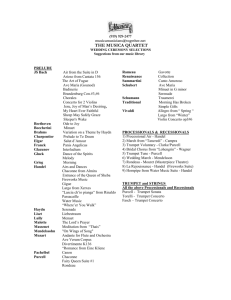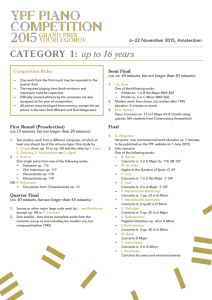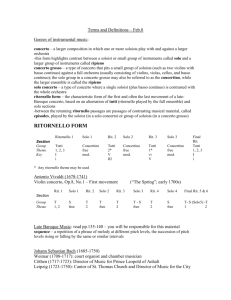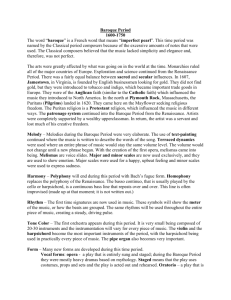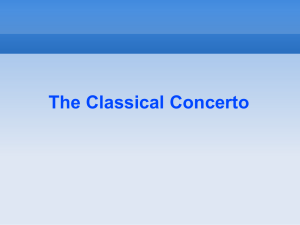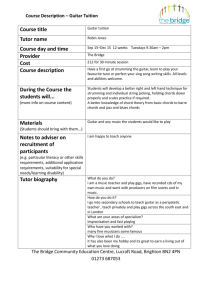Click here for program notes.
advertisement
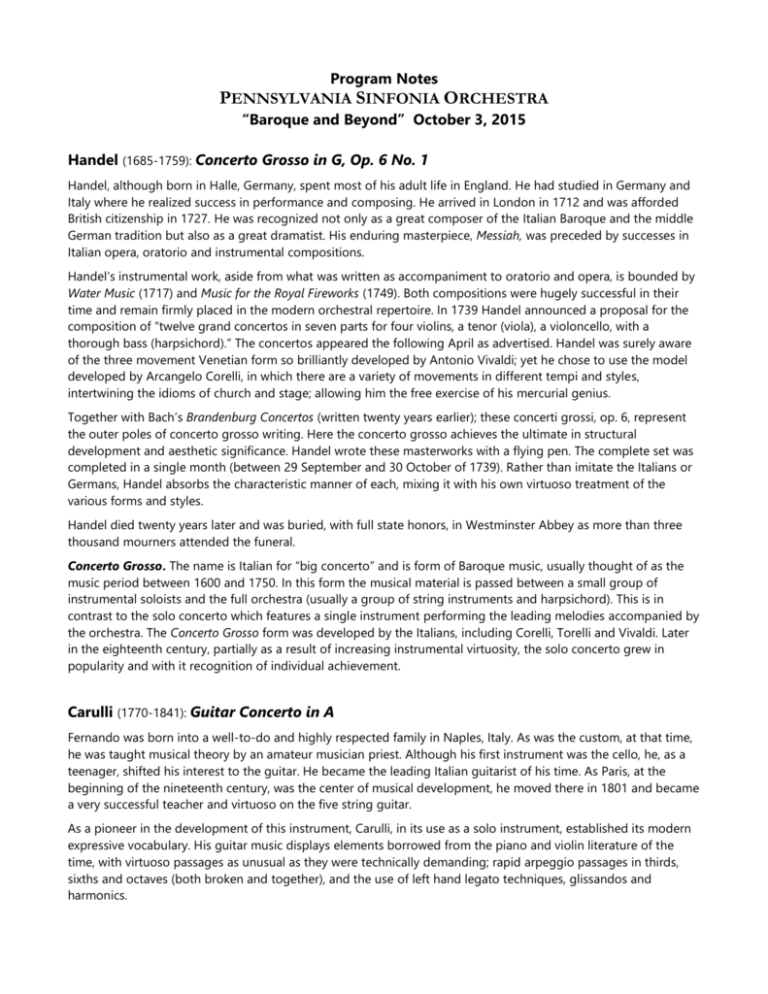
Program Notes PENNSYLVANIA SINFONIA ORCHESTRA “Baroque and Beyond” October 3, 2015 Handel (1685-1759): Concerto Grosso in G, Op. 6 No. 1 Handel, although born in Halle, Germany, spent most of his adult life in England. He had studied in Germany and Italy where he realized success in performance and composing. He arrived in London in 1712 and was afforded British citizenship in 1727. He was recognized not only as a great composer of the Italian Baroque and the middle German tradition but also as a great dramatist. His enduring masterpiece, Messiah, was preceded by successes in Italian opera, oratorio and instrumental compositions. Handel’s instrumental work, aside from what was written as accompaniment to oratorio and opera, is bounded by Water Music (1717) and Music for the Royal Fireworks (1749). Both compositions were hugely successful in their time and remain firmly placed in the modern orchestral repertoire. In 1739 Handel announced a proposal for the composition of “twelve grand concertos in seven parts for four violins, a tenor (viola), a violoncello, with a thorough bass (harpsichord).” The concertos appeared the following April as advertised. Handel was surely aware of the three movement Venetian form so brilliantly developed by Antonio Vivaldi; yet he chose to use the model developed by Arcangelo Corelli, in which there are a variety of movements in different tempi and styles, intertwining the idioms of church and stage; allowing him the free exercise of his mercurial genius. Together with Bach’s Brandenburg Concertos (written twenty years earlier); these concerti grossi, op. 6, represent the outer poles of concerto grosso writing. Here the concerto grosso achieves the ultimate in structural development and aesthetic significance. Handel wrote these masterworks with a flying pen. The complete set was completed in a single month (between 29 September and 30 October of 1739). Rather than imitate the Italians or Germans, Handel absorbs the characteristic manner of each, mixing it with his own virtuoso treatment of the various forms and styles. Handel died twenty years later and was buried, with full state honors, in Westminster Abbey as more than three thousand mourners attended the funeral. Concerto Grosso. The name is Italian for “big concerto” and is form of Baroque music, usually thought of as the music period between 1600 and 1750. In this form the musical material is passed between a small group of instrumental soloists and the full orchestra (usually a group of string instruments and harpsichord). This is in contrast to the solo concerto which features a single instrument performing the leading melodies accompanied by the orchestra. The Concerto Grosso form was developed by the Italians, including Corelli, Torelli and Vivaldi. Later in the eighteenth century, partially as a result of increasing instrumental virtuosity, the solo concerto grew in popularity and with it recognition of individual achievement. Carulli (1770-1841): Guitar Concerto in A Fernando was born into a well-to-do and highly respected family in Naples, Italy. As was the custom, at that time, he was taught musical theory by an amateur musician priest. Although his first instrument was the cello, he, as a teenager, shifted his interest to the guitar. He became the leading Italian guitarist of his time. As Paris, at the beginning of the nineteenth century, was the center of musical development, he moved there in 1801 and became a very successful teacher and virtuoso on the five string guitar. As a pioneer in the development of this instrument, Carulli, in its use as a solo instrument, established its modern expressive vocabulary. His guitar music displays elements borrowed from the piano and violin literature of the time, with virtuoso passages as unusual as they were technically demanding; rapid arpeggio passages in thirds, sixths and octaves (both broken and together), and the use of left hand legato techniques, glissandos and harmonics. Carulli was among the most prolific composers of his time. He wrote more than four hundred works for the guitar, and countless others for various instrumental combinations, always including the guitar. Many of his guitar teaching methods are used in training students of the classical guitar. Along with numerous works for two guitars, there are works for guitar with violin or flute, and three concertos for guitar with chamber orchestra. These concertos composed by Carulli, op. 140, were written for solo guitar, violin, viola and cello. Torelli (1658-1709): Trumpet Concerto in D Giuseppe was born in Verona, Italy and little is known of his younger years although he studied and became known for his abilities as a violinist. Very much an itinerant performer and composer of concerti grossi, he is known to have resided in Ansbach, Germany and Vienna, Austria. He returned to Bologna, Italy in 1701 as a performer on the violin. His interest in the trumpet derives from his acquaintance with the trumpet virtuoso Pelligrino Brandi, and subsequently resulted in the growth of the repertoire for that instrument. Torelli is most remembered for his contributions to the development of the solo instrumental concerto, as well as the concerto grosso. He composed more than 30 concertos for one to four trumpets in Bologna after 1701. He was the most prolific Baroque composer for trumpets.David M. Greene (1984) Grieg (1843-1907): Holberg Suite (from Holberg’s Time) 1885 Grieg, born in Bergen, Norway, is widely considered one of the leading Romantic Era (1790-1910) composers, and his music is a part of the standard Classical repertoire world-wide. His integration of Norwegian (Norway was not independent of Sweden until the first decade of the twentieth century) folk music with his own compositions, put the music of Norway in the international spectrum much as did the work of Sibelius (Finland) and Dvorak (Bohemia). Edvard is regarded simultaneously nationalistic and cosmopolitan in his compositions. Grieg studied and traveled extensively throughout Europe becoming known and admired by his fellow composers such as Tchaikovsky and Liszt. In Norway, particularly Bergen, he is honored as a national hero as he expressed the beauty of Norwegian rural life as well as European models in his music. He was one of the first composers to record both on disc as well as piano roll; and these are available today. The Holberg Suite was originally written for piano in 1884 and later orchestrated by the composer. Subtitled, from Holberg’s Time, it consists of Prelude, Sarabande, Gavotte, Air and Rigaudon. The work abounds in magnificent string effects. The Sarabande is particularly worth careful study, with its opening in four part harmony for second violins and violas with the cellos and first violins entering at the fifth measure, Later, there is a fine effect with solo cello and first violins in unison, second violins on the alto line and violas doubling the melody at the lower octave. The work is a continuing source of beautiful sounds. This is Grieg’s most carefully elaborated piece of orchestration despite the fact that it is confined to strings. As the work was composed to commemorate an eighteenth century individual, it would be hardly be more fitly devised to evoke the atmosphere of that period. The composer was able to set aside his own individuality and compellingly compose in a style not his own yet without but a few of his fingerprints upon the work produced. Dr. Edwin Schatkowski
